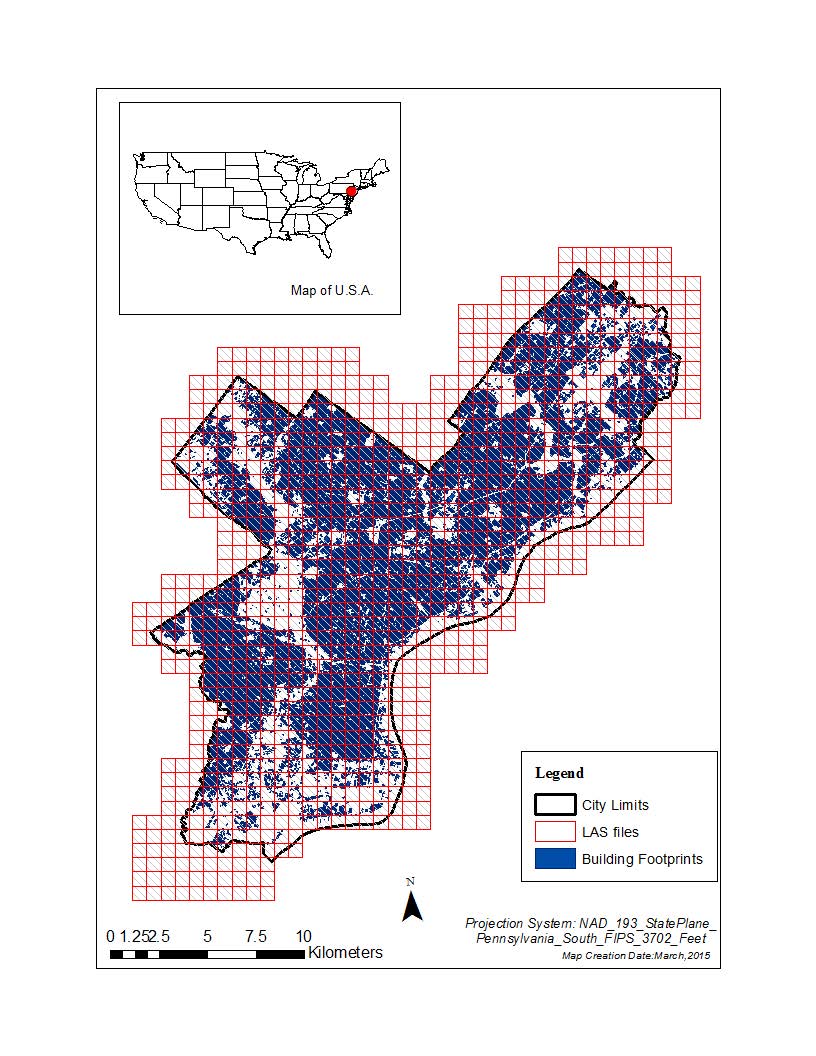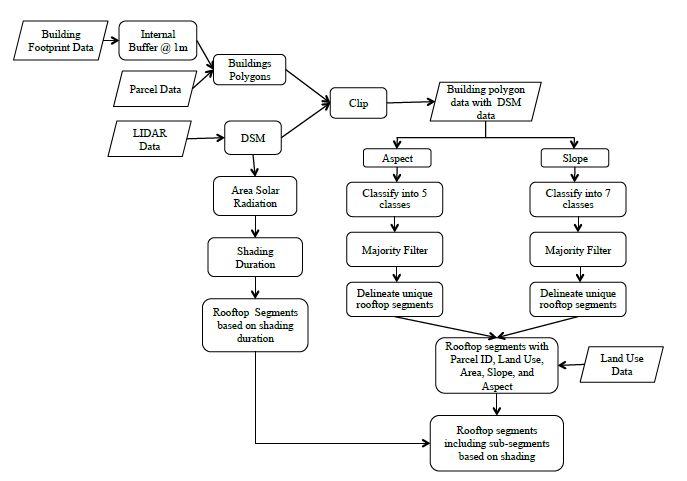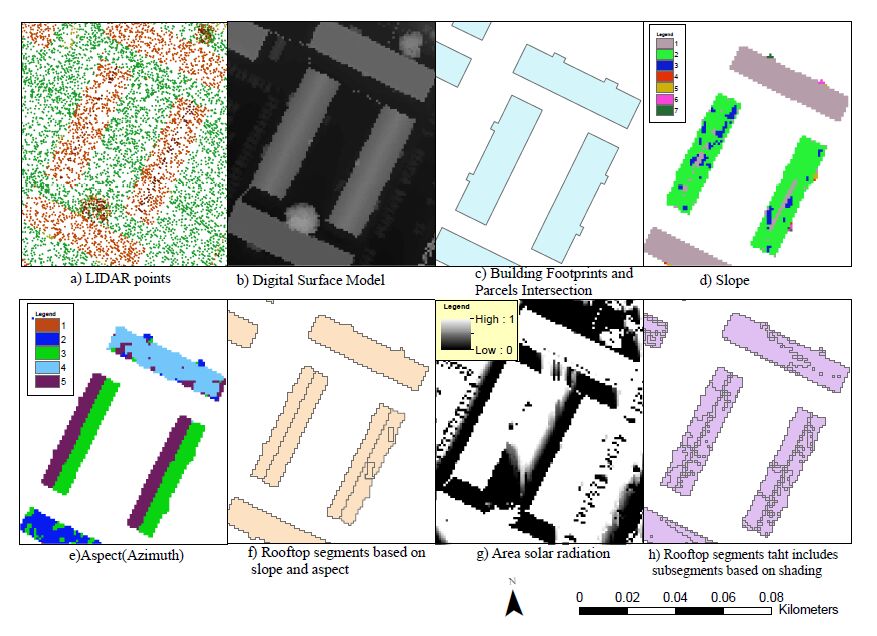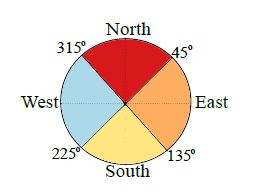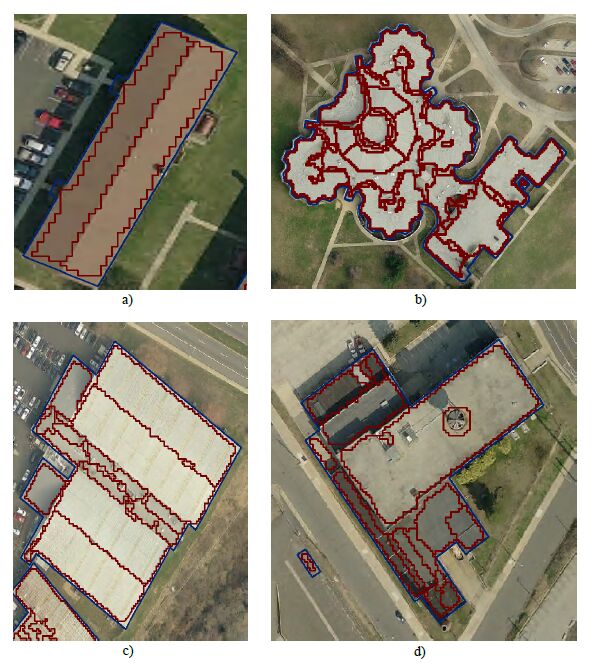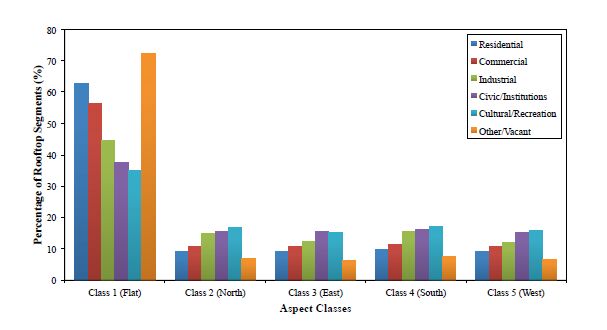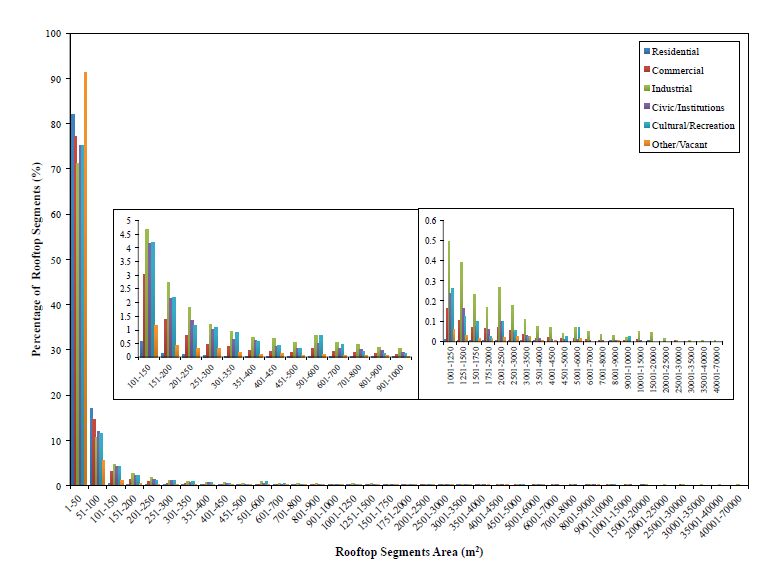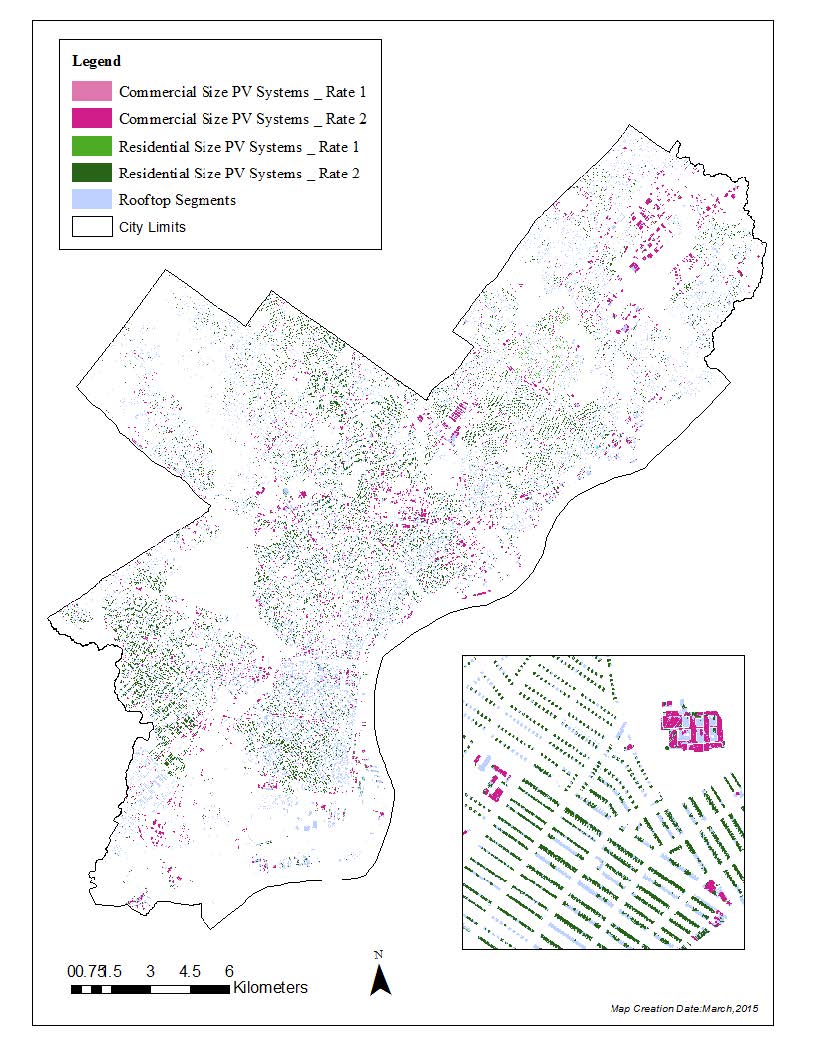As photovoltaic (PV) systems have become less expensive, building rooftops have come to be attractive for local power production. Identifying rooftops suitable for solar energy systems over large geographic areas is needed for cities to obtain more accurate assessments of production potential and likely patterns of development. This paper presents a new method for extracting roof segments and locating suitable areas for PV systems using Light Detection and Ranging (LIDAR) data and building footprints. Rooftop segments are created using seven slope (tilt), ve aspect (azimuth) classes and 6 different building types. Moreover, direct beam shading caused by nearby objects and the surrounding terrain is taken into account on a monthly basis. Finally, the method is implemented as an ArcGIS model in ModelBuilder and a tool is created. In order to show its validity, the method is applied to city of Philadelphia, PA, USA with the criteria of slope, aspect, shading and area used to locate suitable areas for PV system installation. The results show that 33.7% of the buildings footprints areas and 48.6% of the rooftop segments identi ed is suitable for PV systems. Overall, this study provides a replicable model using commercial software that is capable of extracting individual roof segments with more detailed criteria across an urban area.
1.
Introduction
Intellectual property rights can greatly promote regional economic growth have been accepted by us. China has formulated a strategy of building an innovative nation to stimulate economic development. In the new era, in order to achieve a major breakthrough in national economy and promote regional economic growth, it is of great importance to tremendously promote technological progress and industrial upgrading by relying on intellectual property management. From the perspective of policy and specific analysis of the political system, we focus on researching the growth of regional economy of intellectual property investment, technology, market, enterprise and production organization, the influence of output analysis from innovation to the intellectual property rights and translated into innovative products and form innovation in market profits, thus promotes the benign cycle of regional economic growth. The central government, local governments and enterprises all consider independent innovation and intellectual property management as a breakthrough for transformation and upgrading. The improvement of intellectual property management has thus become an important means to develop regional economy. How to improve intellectual property management, the important factors involved in the process of intellectual property management on promoting economic growth and how intellectual property management promotes economic growth have become a concern of managers in various fields. Intellectual property management system is a complex processes to promote economic growth. By revealing the driving force and path of the function of the elements of intellectual property management, enterprises and governments can better improve intellectual property management, promote the output of high-value patents and the transformation and upgrading of industrial structure, so as to enhance the driving force of regional economic growth.
2.
Literature review and theoretical basis
2.1. Literature review
In recent years, there have been several outstanding studies in intellectual property management, such as focusing on intellectual property management system research and intellectual property management ability research. In the research of intellectual property management system, domestic and foreign scholars focus on the operation, collaboration and evolution of the system. In the early research, such research focuses on the research of intellectual property strategy. To study the composition of intellectual property strategic system, from the perspective of intellectual property operation [1], intellectual property strategic resources [2], the process [3] and content of strategic management [4], and emphasize the importance of strategic management thinking in the early stage of intellectual property. In terms of intellectual property management ability, domestic and foreign scholars focus on the composition of ability elements, ability performance, the evolution of ability and the relationship with the growth of enterprises, which fully proves the relationship between the driving force of intellectual property in economic development and economic growth.
Here are many factors to promote economic growth. It has been agreed by many scholars that effective intellectual property management can greatly promote economic growth. Such as foreign scholars Idris, Grossmann V, Steger T M. et al., thought intellectual property had a positive effect on economic growth. Many scholars analyzed the impact of intellectual property on the economy from the perspective of process, and verify this view by analyzing the impact of intellectual property management process on enterprises. By influencing the business process of enterprise knowledge innovation, labor quality and technology level, thus affecting the production function of the enterprise. Through the influence of micro mechanism, the new drive economic development mode transformationcite [5].This is from the micro level of analysis, combined with the changes in the factors of enterprise wealth creation, to analyze the dynamic relationship between the two. Taking the transformation and upgrading of industrial structure as a mediating variable, this paper empirically studies that intellectual property management can indirectly promote industrial green growth. This study uses the Malmquist-Luenberger index model to measure industrial green total factor productivity. This model can systematically analyze intellectual property management, industrial upgrading and economic growth under the same frameworkcite [6]. The above studies show that the elements of knowledge or intellectual property management have an impact on the operation mode and production efficiency of the micro subject through the role of the micro subject, and thus have an impact and effect on the economy. In this process, there are power balance and contest, resource allocation and integration, organizational structure adjustment, the use of new technology, and so on. This process is the focus of this study.
The core of intellectual property management performance evaluation is the design of index system, which comprehensively reflects the level of intellectual property development, coordination, operation and protection. It is significantly correlated with regional economic level, scientific research ability and intellectual property market competition [7]. Intellectual property rights protection is a hot issue related to performance. It is generally believed that the impact of intellectual property rights protection on regional economic growth depends on the technological level of a region and the world's cutting-edge technology. The intellectual property rights protection is positively correlated with regional economic growth when there is a small gap between a region's technological level and cutting-edge technology; otherwise, there is a negative correlation between the two [8]. The FDI intensity has a significant effect on international technology transfer mode [9]. There is a significant positive correlation between intellectual property resources and assets on regional economy, and intellectual property resources can significantly improve regional competitiveness. However, the spatial spillover effect of intellectual property resources is significantly negative, and the increase of intellectual property rights in some provinces has a significant inhibitory effect on the regional competitiveness of surrounding provinces, because spatial spillover effect inhibits the development of surrounding provinces to a certain extent, increase operating costs and hinder the promotion of their regional competitiveness [10], Intellectual property strategy has a significant positive effect on technological innovation performance [11].
In the above studies, the factors related to intellectual property, such as management, resources, assets or a process or link of intellectual property management, or the role of intellectual property protection in economy or performance, are generally studied with technology as an intermediary factor, indicating that technology, as an endogenous factor of economic growth, can effectively drive the positive effect of other factor endowments on economic growth. Furthermore, the impact of intellectual property on enterprises, regional economy or competitiveness is mainly derived from technological innovation, industrial structure upgrading and economic transformation, whether in terms of resource or management. Draw lessons from the ideas of the above scholars, this study is based on the perspective of intellectual property management, under the guidance of intellectual property strategy, with intellectual property input, application, output as a research path.From the macro government support for intellectual property and financial investment, government-industry cooperation and financial support are put into the research system.From the micro enterprise, intellectual property creation and output process is included in the system. In the intermediate link, the technology market and other trading factors are considered into the research system, then has built a research framework.
2.2. Theoretical basis
It is not a simple process for intellectual property management to promote regional economy, wherein technological innovation serves as a bridge between the two and plays an intermediary role in their relationship. It is a complicated economic operation process from intellectual property management, value realization to the promotion of regional economic growth, in which the transformation of knowledge innovation into intellectual property, the role of intellectual property on technological innovation, the transformation of technological innovation into products, and the ultimate realization of value increment are involved. This process is a unified organic whole, which facilitates the positive effect of intellectual property on economic growth. This is also a complex knowledge transformation process, in which various elements and subjects develop in a coordinated manner. This complex system can be divided into several subsystems, including knowledge innovation system, intellectual property development and management, operation management and intellectual property protection of intellectual property rights management subsystem, technology innovation system, value-added and implementation system. Each subject and element coordinate and support each other, forming a complete seamless docking system. In the process of system operation, the main body and elements are mutually coordinated and supported. In this complex system, the goals and directions of different subjects are inconsistent, so are the roles and responsibilities they assume in the subsystems. In addition, the composition of the relationship between various elements depends on the attitudes and abilities of different subjects, and the integration of elements depends on the coordination and operation abilities of the subjects, as there are both synchronous and transitive relationships between subsystems. In such a complex relationship, the interrelationship among these elements cannot be completely understood only by subjective understanding or analysis. Instead, tools and methods are required to get insights into the docking relationship between subjects. System Dynamics (SD) is a tool that helps us to systematically understand the feedback relationship among factors, analyze the interrelation and constraint relationship among factors, and discover the causality of interaction and influence. By studying the structure of the system and analyzing the force and resistance based on the close dependence between the system behavior and the internal mechanism, the root causes of the problems can be identified from the internal structure of the system, thus achieving the purpose of understanding the function of the system. System dynamics is used to analyze the driving effect of intellectual property on regional economy, mainly for the following reasons: 1) The realization of regional economic growth by intellectual property management is a complex dynamic system. The regional economic growth depends on the cooperation and resource allocation of the main body. Under such soft constraints, different management modes or changing cooperation modes will produce different effects and results. 2) The effect of intellectual property management on regional economic growth has a causal feedback relationship with path, and such relationship is interlinked with a complex structure. 3) It is a long process from input of intellectual property to its effect on regional economic growth. There is a time difference in this process, which depends on the chain process from intellectual property, technological innovation, innovation output and value realization. 4) The results are directly affected from intellectual property management, technological innovation and value realization where there are a large number of variables and high-order nonlinear systems. 5) A thorough understanding of the process and factors of complex process and chain results and the structural reasons behind them can explain why the government's decision-making behavior is related to the behavior and ideology of the subject.
The introduction of several intellectual property policies can promote the top-down attention to intellectual property strategy and the formulation of strategy. In recent years, the investment strategy in the intellectual property pledge financing has made particularly remarkable achievements in transforming the intellectual property development of knowledge and intellectual property into innovative assets. Regional economic development can promote the increase of financial funds in the field of intellectual property, the government attaches more attention to the development of intellectual property, actively build an intellectual property trading market, promote the transfer and transformation of intellectual property, so as to promote enterprises to obtain innovation profits. From the perspective of enterprises, the increase of strategic and capital investment significantly improves the innovation ability of enterprises, thus promoting the transformation of intellectual property rights and forming innovation benefits. The above constitute three closed causal rings that can explain the internal reasons and dynamic direction between intellectual property rights and economic development, which is the most powerful tool for systematic thinking. These relational rings are linked by multiple open feedback chains, forming three causal feedback loops. Fully considering the process of transforming intellectual property rights into economic growth and its hidden reasons, system dynamics is able to describe the results and causes of its dynamic changes, so as to provide reliable reference and basis for the government to improve intellectual property rights management and optimize operation mechanism.
3.
SD analysis on how intellectual property management promotes the regional economic growth
3.1. Determination of system boundary
The large-scale system for intellectual property to promote regional economic growth can be divided into three subsystems. The boundary of the system can be accurately determined, and variables closely related to modeling purpose can be integrated into the system. This complete system involves the application of intellectual property rights, the formation of technological innovation capabilities, the generation of innovative products, the realization of value added and the acquisition of innovative benefits, so as to promote regional economic growth. In this process, the system boundary is the whole process of generating and using intellectual property and promoting economic growth. This process is seamless that does not include the process of how invisible knowledge and explicit knowledge are used to form intellectual property rights, nor does it include the social impact and environmental protection of regional economy in the past, which are not discussed in this study.
3.2. Analysis of multiple subject elements
The driving process of intellectual property management for economic growth involves multiple interrelated and interdependent subjects. In this process, subjects not only identify with each other in behavior, but also get familiar with each other's goals. There is also an economic game, in which the restructuring and distribution of interests are completed, which requires a contract to bind each other. The process of reaching agreement between the two parties implies that the main elements are required to achieve a certain goal, but the balance is temporary. Due to the change of external conditions or the principal under the premise of unclear responsibilities and obligations of both sides, there will be a lot of uncertain risks, which prevents the goal from being achieved to a certain extent and results in losses or even legal disputes and liabilities. The intellectual property management involves three main bodies, namely enterprise, government and school. From the perspective of enterprises, it involves its internal professional intellectual property management personnel, personnel from intellectual property administrative departments or intellectual property management centers of development zones and industrial agglomeration zones, supervisors of intellectual property offices in cities divided into districts and supervisors of administrative units. In the stage of technological innovation, the integration of industries, universities and research institutions mainly involves subjects such as universities, research institutions, enterprises and governments and activities such as technological application, communication, dissemination, transfer or commercialization. In addition to government and enterprises, it also involves financial institutions. In the stage of value realization, manufacturers will trade innovative products on the market, which will also involve enterprises, government and market players. The enterprises provide innovative products, and the demanders pay for them. The demanders can be enterprises or government. This transaction process is realized through the market, and market players are also the main participants.
3.3. Analysis of influencing factors
From the perspective of system, intellectual property management and regional economic growth are affected by both internal and external factors, which can promote or hinder system operation. For example, capital investment and policies related to intellectual property will promote the transformation of intellectual property and regional economic growth. In addition, there are some negative factors, such as intellectual property theft and unfair market competition, which are all negative forces in the operation of this system.
3.3.1. analysis of driving factors of intellectual property management for the regional economic growth
(1) Implementation of intellectual property strategy. Since the implementation of the Outline of the National Intellectual Property Strategy in 2008 [12], remarkable achievements have been made in intellectual property management nationwide. The ownership of intellectual property has grown rapidly, and the quality of intellectual property has been greatly improved. Some high-value patents have gradually emerged. The awareness of intellectual property protection has been enhanced, business environment has been greatly improved, and the overall awareness of intellectual property rights has been significantly enhanced. The fundamental environment for intellectual property rights has been gradually consolidated. At the same time, the international exchange activities of intellectual property rights have been further standardized, the exchange and cooperation mechanism has been further improved, and the international influence has been significantly increased.
(2) Policy support. China's economic development requires the transformation of kinetic energy and the adjustment of industrial structure. The adjustment of industrial structure requires innovation and industrial integration to promote the emergence of new industries. The original institutional basis cannot no longer adapt to new industrial development and industrial structure adjustment. Produce mutations and structural upgrades [13]. The institutional basis includes various policies formulated by the government to realize economic and administrative functions, such as policies to stimulate market competition, government innovation support policies, financial policies, intellectual property protection policies, etc [14]. Government subsidies can effectively stimulate innovation in strategic emerging industries, and bring additional effects of guiding enterprises to tackle technical problems and encouraging external investors for enterprises' R & D. The government subsidy has the signal effect, which transmits the strategic direction of the national key development industries and the tendency of future policy changes to the market, thus changing R & D expenditure decision of enterprises and the investment behavior of external investors and further effectively guiding and promoting enterprises' own capital and diversified social capital to follow up R & D investment.
(3) Construction of the industry-university-research cooperation network. A variety of new organizations will emerge, forming a criss-crossing network in the process of industry-university-research cooperation, in order to achieve different purposes and adapt to the competitive environment. Such networks make up a dynamic process of self-organization and self-adaptation, and the pursuit of interests, resources or values by different subjects will make the networks change constantly. Cooperation network can help enterprises to utilize external resources and strengthen the core technologies for common benefits among all the network members [15]. The cooperation networks evolve dynamically to meet changes in user needs, technological environments, or national policies. The changing process of innovation network is accompanied by the dissemination of knowledge, the flow of personnel, resource re-allocation, choice of new coupling relationship in the cooperation between government, enterprises and academia, and the realization of organizational evolution by interacting with the environment. As cooperation gradually deepens and matures, network structure is relatively stable, synergistic effect will play a "multiple complementary" advantage to achieve multiplier effect.
3.3.2. Analysis of resistance factors of intellectual property management for the regional economic growth
(1) Intellectual property financing risks. The development of intellectual property requires a lot of funds to support technological innovation. However, due to the asymmetry of contract interests, enterprises lack corresponding financial support in the process of intellectual property creation. Financing has become the biggest obstacle in the creation of intellectual property, and the use of intellectual property pledge financing is an important means to obtain funds. The pledge of intellectual property involves many risks, such as complexity, value fluctuation and difficulty in disposal, which is undoubtedly a great challenge for the government and enterprises.
(2) Risks of intellectual property strategic selection. The highly uncertain market environment will have a huge impact on enterprises' R & D. The true value of intellectual property lies in that enterprises use it as a marketing strategy for value appreciation [16], research, development and growth [17]. In the era of knowledge economy, with the increase of environmental uncertainty, the acceleration of technology and product upgrading, and the increasing mobility of scientific and technological personnel, traditional intellectual property strategy on the basis of property control is difficult to maintain the original competitive advantage. Enterprises have a low ability to achieve comprehensive control of intellectual property. Therefore, in an uncertain environment, the formulation of intellectual property strategy is also faced with risks and uncertainties. Choosing the appropriate strategy is an important issue facing enterprises.
(3) Non-standardization and standardization of intellectual property management. To implement the strategy of intellectual property rights, intellectual property management has been significantly improved. However, people in different regions have different degrees of understanding of the importance of intellectual property management, and have different investments in intellectual property management, including systems, regulations and security systems. There is a lack of perfect intellectual property application system and norms. Even in companies with planned and systematic protection of intellectual property, intellectual property management departments fall into an awkward dilemma, usually upset with how to integrate corporate management as an indispensable link. And they are often regarded as looking for trouble and making trouble for other departments. Therefore, they cannot get effective support and cooperation in their work, which directly affects the efficiency and effect of intellectual property management.
(4) Spillover of knowledge. The "competition and cooperation relationship" among enterprises is widespread. In the process of project cooperation or implementation, enterprises' advantageous technologies and key skills will inevitably leak out, resulting in the leakage of intellectual property and the imbalance of intellectual property resource allocation. In addition, the proximity of geographical space, the frequent exchange and flow of scientific and technological personnel, and the exchange of scientific and technological information are all positive externalities. Without reasonable compensation, the enthusiasm and efficiency of enterprise cooperation will be affected.
4.
SD model construction of the driving mechanism of intellectual property management on the regional economy
4.1. Analysis of the evolution process of the driving mechanism of regional economy driven by intellectual property management
4.1.1. Driving mechanism of intellectual property management for technological innovation
Intellectual property management involves input, application, transformation and protection of intellectual property, where multiple subjects play roles in different processes. From the macro level, the input of intellectual property depends on the economic foundation and development status of local governments. The financial expenditure of economically developed regions requires more resources for the input of intellectual property. Therefore, the increased input of intellectual property will positively affect the output of intellectual property. From the micro level, enterprise's emphasis on intellectual property will be an important basis for their intellectual property strategy. No matter from investment, operation and conversion, manpower, materials, resources and financial resources should be arranged strictly according to the strategy. In order to encourage the development of intellectual property rights, intellectual property will be used to produce new products, promote technological innovation, seek innovation products and then traded on the market for innovative benefits. In the process of R & D investment, the coordination between enterprises, universities and government is promoted, and knowledge is transformed and enhanced in the coordination process, resulting in knowledge exchange. Enterprises pay attention to the research and development of key technologies for enterprise development and promote the increase of the ownership of core technology patents, which is how intellectual property rights are produced. In order to gain advantages, enterprises vigorously promote the industrialization of patented technology. By making profits in the market, the market value of intellectual property is realized. This is a Mosaic and interaction process between intellectual property management and enterprise technology innovation to realize the value of the process. The management process of intellectual property and the technological innovation of enterprises are a parallel and constantly interwoven process, and it is also how intellectual property promotes the technological innovation of enterprises. The influence of intellectual property management on technological innovation is also reflected in the following aspects: First, intellectual property management can promote technological innovation. To a certain extent, intellectual property management can provide guidance for technological innovation, lead enterprises to develop towards the expected direction, promote enterprises to allocate resources reasonably, and improve the efficiency of technological innovation. Second, intellectual property management is involved in the entire process of enterprise technology innovation and can integrate and motivate all kinds of innovative thinking. Technological innovation is the basis and premise of intellectual property management and intellectual property management is the extension and development of technological innovation, which complement each other. In addition, intellectual property management can also protect the technological innovation of enterprises to a certain extent, and intellectual property is the basis of continuous innovation.
Based on the above analysis, the following causal loop is formed:
Regional economic output value–government financial input–intellectual property management input–knowledge achievement stock–technology market transaction amount–transformation rate of scientific and technological achievements–new product sales revenue–innovation revenue–industrial output value–GDP growth rate–regional total output value.
The loop mainly reflects the importance of local government to intellectual property management, the level of intellectual property management and the impact of regional intellectual property on regional enterprises' technological innovation and regional gross output value.
4.1.2. The driving mechanism of technological innovation on the performance
Enterprises are constantly seeking technological innovation in the competition. First, the effective allocation and reasonable adaptation of innovative resources can promote the continuous diffusion of innovative technologies, and then realize the research and development of innovative products. The benefits of innovation have already been reflected in market transactions. In the industrial chain, upstream and downstream enterprises can imitate, track and cooperate with innovative technologies and products to avoid being eliminated, which promotes a series of enterprises to continuously innovate technologies. In this process, it will be restricted by market factors. The higher the degree of marketization, the more attention will be paid to market signals and price evolution, and the more fierce competition among enterprises. In the fierce market competition mechanism, in order to survive and develop, enterprises continue to invest capital and manpower, innovation technology, in order to maintain industrial competitive advantages and industrial chain competitive position. In the process of continuous technological innovation, new products, new services and new processes are introduced and traded in the market so as to obtain high monopoly profits of new technologies. From the market perspective, industrial chain enterprises are constantly innovating, and some enterprises have made major breakthroughs in technological innovation with the technological innovation cooperation between upstream and downstream enterprises as a driving force. Some enterprises have even left the industrial chain to form new competitive technologies and products. In pursuing of technological innovation system, In the pursuit of technological innovation system, the innovation ability of the whole industry and enterprises rises to a new height, which promotes the industrial upgrading and improves the innovation ability and performance of the whole region. Based on the above analysis, the following causal loop is formed:
Ⅰ. (technological innovation driving force–industry-university-research cooperation (effectiveness of industry-university-research cooperation and degree of collaboration with small and medium-sized enterprises)–innovation risk–R & D input–sales revenue of new product invested by enterprise innovation factors–revenue of enterprise T–innovation revenue).
This loop mainly reflects the strength of technological innovation motivation of universities, scientific research institutions and enterprises, which are the main innovation subjects of industry, university and research, and the influence of enterprises' ability to carry out technological innovation activities on the regional total output value.
Ⅱ. (intellectual property strategy–policy support–intellectual property pledge financing capacity–market purchasing power–new product market demand–innovation impetus–enterprise innovation factor input–new product–new product sales revenue–innovation income).
The loop mainly reflects the degree to which the government attaches importance to intellectual property management and the ability to obtain innovation benefits considering market factors, such as policy support, intellectual property pledge financing etc. Considering the market environment, the influence of technological innovation level on regional total output value is also considered. The objective is to emphasize the importance of implementation of intellectual property strategy and government policy support.
4.1.3. Analysis of the subsystems of the dynamic system and their functional relations
Analyzing the above driving mechanism, we can conclude that the system of intellectual property rights for the regional economic growth consists of three subsystems: intellectual property management system, technology innovation driving system and government policy supporting driving system. The intellectual property management system consists of two parts. One is regional intellectual property management system, which leads the development of regional intellectual property, including intellectual property system, culture, intellectual property strategy, etc. The government, enterprises, research institutes and intermediary organizations are main bodies of this system. The other is enterprises' intellectual property management system, namely internal intellectual property management mechanism, self-organization system and intellectual property strategy. The technology innovation system includes both the large system of government, industry, university and research, and enterprise technology innovation system. The large system and the micro main body system interweave with each other, forming a close technical innovation cooperation network, and acting on the regional economic system at the same time. Therefore, these three systems are all open systems that interact with each other. Each subsystem is closely connected, driven and connected with each other. There is also a close coordination and cooperative operation relationship between systems, thus forming a powerful cooperative dynamic network system. The system power network is a dynamic system. The change may be caused by changes in the direction and number of internal elements, or by changes in the external environment. The stability of the drive system is a close coupling between subsystems. The coupling mechanism between the two depends on the cooperation intention and the interest relationship between the subjects, and also on rational resource allocation and sound system culture.
4.2. Construction of SD dynamic model of intellectual property management for the regional economic development
Based on the above analysis, a causal diagram was established, as shown in Figure 1.
5.
Conclusions
Using the system dynamics theory, the driving process of intellectual property management for regional economic growth was analyzed. Firstly, the system boundary was determined, and the driving force and resistance factors of intellectual property for economic growth were analyzed. From the perspective of intellectual property management process, the driving force and resistance factors restrict and function each other, forming an integrated system. This system is composed of three subsystems, which interact and restrict each other. Under the interaction of these three subsystems, intellectual property and economic growth simultaneously evolve. Using the research results of subsystem analysis, the following problems can be solved:
(1) Address the black box issues from intellectual property rights to regional economic growth. The whole system is divided into three closely connected subsystems. On the one hand, according to analysis, the whole process involves intellectual property rights, technological innovation and regional economic growth. On the other hand, it is based on the view that the macro environment acts on the micro subject level, the transformation of innovation benefits from technological innovation to new products is realized. In the long run, the government plays a leading and supporting role in the regional economic growth. Whether from the financial input, the construction of trading institutions or policy support, it plays a crucial role in the whole system.
(2) From the perspective of the whole system, enterprises' technological innovation plays an intermediary and realization role in intellectual property rights and regional economic growth. After all, intellectual property management ability is improved by transforming intellectual property into new products for innovative benefits and thus regional economic growth. In this link, the cooperation between enterprises, universities and research institutes, technology transfer and intellectual property atmosphere have a direct impact on enterprises. In addition, external market competition and market mechanism play a stimulating role on enterprises, stimulating them to continuously seek innovation in the competition.
(3) The three subsystems are interrelated and interdependent. It can be seen from the diagram of system dynamics that enterprises' technology innovation system is the link connecting the other two subsystems, and is also the key subject to achieve the goal. The other two subsystems analyze the effect of intellectual property rights on regional economic growth from different perspectives. Firstly, the government allocates and integrates resources from the perspective of human resources and property. In addition, in terms of government management, effective institutional arrangements should be made to stimulate the innovation potential of action subjects, accelerate the transfer and application of scientific and technological achievements, and promote technological progress and economic growth. The government should also introduce relevant science and technology policies as leverage to form effective coordination among science and technology departments, enterprises, universities, intermediary agencies and platform operators and establish online and offline technology market trading platforms. The government is also advised to provide a variety of technology docking activities to build a service platform for efficient technology and capital docking, a supporting platform for promoting the industrialization of scientific and technological achievements and a comprehensive service platform for promoting the transfer and transformation of technological achievements.
(4) Further, according to the above analysis of causality and circuit, build system dynamics model, establish equations, intellectual property to promote regional economic growth simulation and simulation, realize intellectual property to drive the key factors, dynamics between the key factors, determine the causal relationship between the key factors, grasp the causal degeneration, to control the operation results of intellectual property, promote regional economic development.
Acknowledgement
This work was supported by the National Social Science Foundation of China.16BZZ074.
Conflicts of interest
The authors declare that they have no conflicts of interest to report regarding the present study.
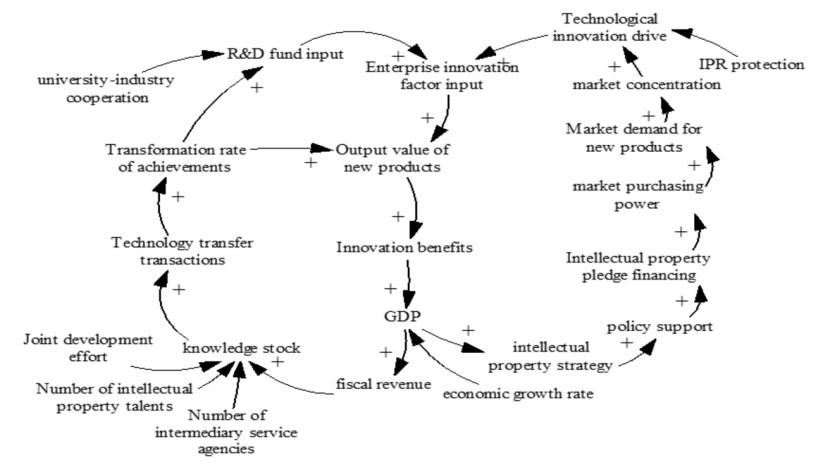









 DownLoad:
DownLoad:


